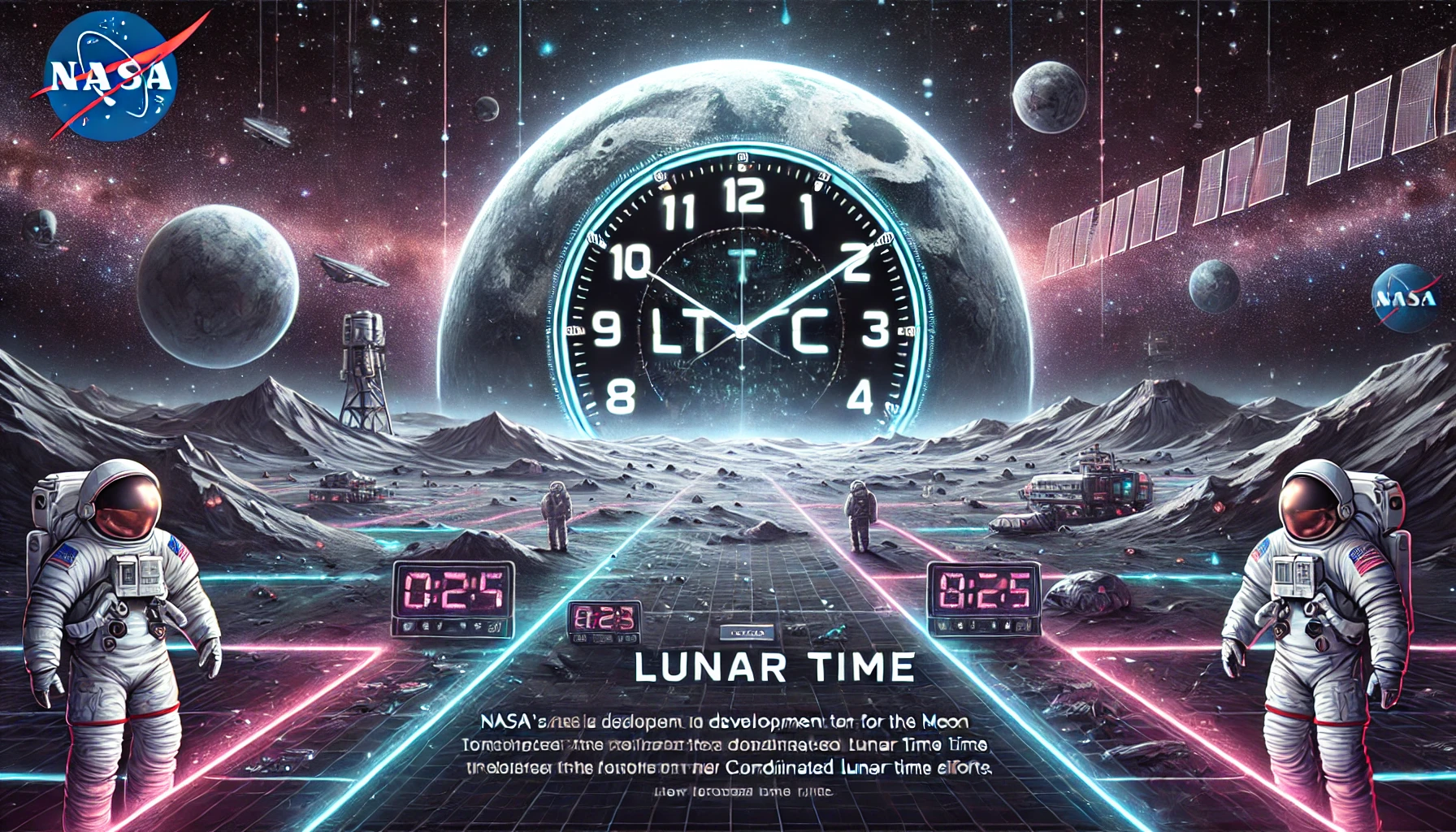NASA Moon Time Zone: An Introduction to Coordinated Lunar Time
NASA Moon Time Zone: NASA’s Artemis program and future space exploration plans have sparked discussions about a groundbreaking concept: creating a time zone for the Moon. As more space missions are planned by NASA and international space agencies, a need for a NASA Moon time zone has become evident. Establishing a standard lunar time will help synchronize missions and ensure precise communication and navigation on the Moon’s surface. This time standard is referred to as Coordinated Lunar Time (LTC), and NASA is leading efforts to implement it by 2026.
In this article, we’ll explore why NASA is developing this lunar time zone, how it relates to upcoming missions like Artemis, and what the broader implications are for global space exploration.
What Is Coordinated Lunar Time (LTC)?
Coordinated Lunar Time (LTC) is NASA’s proposed solution to the growing need for a timekeeping standard on the Moon. Currently, all space missions—including those to the International Space Station (ISS)—use Earth-based time zones, primarily Coordinated Universal Time (UTC). However, as space exploration extends beyond Earth’s orbit to the Moon and eventually Mars, new challenges arise due to the Moon’s unique environment.
Why Is a Moon Time Zone Needed?
Timekeeping on Earth relies on the planet’s consistent rotation and gravitational forces. The Moon, however, experiences different gravitational conditions, which means that clocks on the Moon would tick faster than those on Earth—by about 58.7 microseconds per day. Without a universal time standard, missions from different space agencies could face significant coordination issues.
Establishing a NASA Moon time zone will ensure:
- Precision in communication: Consistent time zones will make it easier for different space missions to coordinate.
- Navigation accuracy: Missions like lunar landings and docking procedures rely heavily on synchronized timing for success.
- Scientific research efficiency: Time-sensitive experiments will benefit from having a unified time reference.
NASA’s lunar time system will be a critical aspect of future space exploration, aiding missions from the NASA Artemis program and other international agencies.
NASA’s Artemis Program and the Need for Lunar Time
NASA’s Artemis program is an ambitious mission aimed at returning humans to the Moon by 2026, followed by long-term lunar habitation and further exploration of Mars. The NASA Artemis program lunar time is essential for the success of these missions, which will involve multiple landings, the establishment of lunar bases, and long-term human presence on the Moon.
Artemis and Coordinated Lunar Time
NASA aims to launch Artemis III in 2026, with the goal of landing astronauts on the lunar surface. But this mission, along with future lunar endeavors, will require precise coordination. Without a lunar time zone for Artemis missions, space agencies would face serious logistical challenges. From docking spacecraft to landing modules, every second counts in space exploration.
By implementing Coordinated Lunar Time (LTC), NASA ensures that astronauts and mission control teams can operate efficiently and safely. LTC will allow NASA to synchronize landings and enable scientific missions to collect data in real time.
Why Does NASA Want a Time Zone on the Moon?
You might wonder, why does NASA want a time zone on the Moon in the first place? The answer is rooted in the complexities of operating in a lunar environment. The Moon’s gravity is weaker than Earth’s, causing time to move slightly faster than it does here. This difference may seem negligible, but in the context of complex space missions, even tiny errors can result in catastrophic consequences.
Challenges in Developing a Lunar Time Zone
Creating a time zone for the Moon isn’t as simple as adopting Earth’s standards. Unlike Earth, the Moon has no atmosphere, experiences extreme temperatures, and has lower gravity, all of which affect timekeeping systems. The lunar time zone NASA space exploration initiative needs to take these factors into account.
Additionally, timekeeping systems on the Moon must be resilient enough to work independently of Earth in case communication is lost. NASA’s proposed lunar time system must also be scalable, allowing it to be extended to other celestial bodies like Mars.
Potential Benefits for Global Space Collaboration
One of the driving forces behind the NASA Moon time zone initiative is its potential to foster international collaboration. Space agencies worldwide are planning lunar missions, including the European Space Agency (ESA), which has already proposed a lunar time standard. A universal lunar time zone would enable international missions to operate smoothly together, reducing the risk of errors and ensuring that spacecraft from different countries can dock and land without complications.
NASA Developing Coordinated Lunar Time for Global Missions
NASA’s vision for Coordinated Lunar Time (LTC) is not just a project to aid its own missions; it’s part of a larger effort to establish global space exploration norms. As private companies and space agencies such as the ESA and China prepare for lunar missions, time synchronization will become even more crucial.
NASA is working with international bodies like the International Astronomical Union (IAU) to develop this time system, ensuring that NASA developing Coordinated Lunar Time benefits all space-faring nations.
Why Global Participation Is Crucial
As more countries and private companies aim for the Moon, the need for a shared time reference becomes clear. NASA’s role in leading the charge to establish Coordinated Lunar Time (LTC) showcases the importance of international space collaboration. The unified time standard will benefit:
- Space navigation and communication: Missions from different countries will be able to coordinate more efficiently, reducing the risk of accidents.
- Scientific data collection: With a shared lunar time system, experiments and data collection will be more accurate and synchronized.
- Long-term habitation: Lunar bases, which will eventually support human life for extended periods, require precise timekeeping for everything from life support systems to resource management.
How Will the Lunar Time Zone Work?
The concept of a Moon time zone is groundbreaking, but how exactly will it work? One option is for the Moon to have a single time zone, unlike Earth, which has multiple. A single lunar time zone simplifies coordination between missions and makes timekeeping more manageable.
Key Features of the Proposed Lunar Time Zone:
- Resilience: The lunar time system must continue to function even if contact with Earth is lost. NASA is exploring ways to ensure that the time zone is self-sustaining.
- Scalability: While initially focused on the Moon, the lunar time zone will eventually be used on other celestial bodies, including Mars. This scalability will ensure that space exploration beyond the Moon can also benefit from synchronized timekeeping.
- Accuracy: The time system must be accurate enough to measure even short intervals, which is crucial for spacecraft landing, docking, and scientific experiments. This level of precision will ensure that NASA lunar missions time zone remains a vital tool for future exploration.
The Future of Space Exploration with Coordinated Lunar Time
Looking forward, Coordinated Lunar Time (LTC) is set to play a crucial role in the expansion of human presence on the Moon and beyond. As NASA prepares to establish lunar bases and enable long-term habitation, the Moon’s time zone will be a cornerstone of this new era in space exploration.
Additionally, the development of a lunar time zone will pave the way for future missions to Mars. The knowledge gained from creating a NASA Moon time zone will inform how we approach timekeeping on other celestial bodies, further enabling the colonization of space.
Why NASA’s Moon Time Zone Matters for the Future
As we’ve explored, NASA’s development of Coordinated Lunar Time (LTC) is much more than a technical exercise. It’s an essential part of preparing for the future of space exploration, enabling precise coordination for missions, ensuring navigation accuracy, and fostering international cooperation. The NASA Artemis program lunar time will not only aid astronauts but will also help international space agencies and private companies achieve their lunar ambitions.
In the coming years, NASA developing Coordinated Lunar Time will set the stage for a new era of space exploration. By 2026, we can expect the Moon to have its own time zone, one that will support everything from lunar bases to scientific research, and eventually, human life beyond Earth. For those eager to learn more about the technical aspects of space exploration and how these innovations impact education and scientific progress, visit Regent Studies.
For further reading, this external article offers a more detailed look at NASA’s plans for establishing a lunar time zone.




